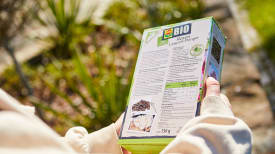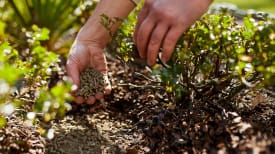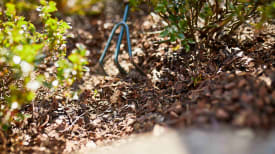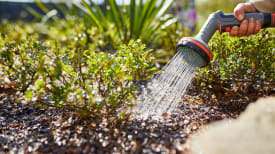Frequent search terms

- COMPO
- Guide
- Plant Care
- Basics
- Fertilisers and plant protection
- Sheep's wool as fertilizer?
Sheep's wool as fertilizer
Our growing awareness of nature and the environment is accompanied by a growing desire to make our own patch of earth more sustainable and nature-orientated. This also applies to the fertilisation of plants. People have called sheep's wool a natural fertilizer for some years now. But how well does sheep's wool actually fertilise?
Can sheep's wool be used as fertilizer?
Bleating, with big floppy ears and fluffy fur, they stroll across the meadow and enjoy chewing the grass. What looks like a cosy idyll at first glance turns out to be genuine landscape management when you take a second look, for without sheep many green spaces would simply disappear. Dykes in particular benefit from our woolly four-legged friends, which make the subsoil more compact as they constantly tread on the ground and thus prevent dykes from failing. The airports in Hamburg and Nuremberg have also recognised the benefits, relying on sheep as natural lawn mowers.
A substantial amount of wool accumulates each year due to sheep farming. Although this matted, oily wool is often not suitable for the production of clothing, it lends itself perfectly to use as a fertilizer. This is because sheep's wool has a number of properties that have a very positive effect on plant growth. You can either use fresh and unwashed raw wool directly from the sheep or sheep's wool in the form of pellets.
Pros and cons of sheep's wool
Sheep's wool has a number of special properties that can be made use of when fertilising plants.
Some key benefits of sheep's wool:
- Rich in nutrients: Unwashed raw wool contains various macronutrients that are vital for plants. Most notable here are nitrogen and potassium, which is why fertilization with sheep's wool is especially popular among plants that need a lot of nutrients, such as tomatoes, pumpkins or peppers. In addition, sulphur, phosphate and magnesium are also present.
- Slow release: A large part of sheep's wool consists of keratin. This fibrous protein is also what our hair and nails are made of. Keratin is broken down in the soil by soil organisms. This process of decomposition, during which nitrogen is released for the plants, can take up to a year, depending on the weather. That's why we speak of a slow-release fertilising effect – or slow-release fertilizer.
- Sustainable: If the wool is sourced locally and comes from free-range sheep used for landscape management, it's a kind of naturally renewable raw material.
- Water-retaining: Normally, sheep's wool does not retain water. Sheep produce a special wool wax (lanolin) that makes the wool slightly oily and water-resistant. Organisms in the soil break down this lanolin. Once the fat is removed, the wool can absorb and retain excess water.
- Activates soil life: The incorporation of organic raw materials such as sheep's wool activates soil organisms. They break down the fertilizer and in so doing make the nutrients available to plants.
This means that sheep's wool can be used as a fertilizer – and is also used as a mulching material in some gardens. But there are also a few critical points that need to be considered when fertilizing with raw wool:
- Not an 'all-rounder': Although sheep's wool contains a wide variety of nutrients, nitrogen is in first place at almost 12%, potassium stands at about 5% and phosphate, magnesium or sulphur lag a long way behind. Accordingly, if you want to supply your plants with all the required nutrients, you will need some supplementary fertilizers. Otherwise, the diet could be quite one-sided.
- High pH: The pH level in raw sheep's wool is quite high, meaning it is not suitable for plants that prefer an acidic, rather woody soil, such as blueberries, rhododendrons, azaleas or hydrangeas. Such plants feel at home in soils with a low pH. Other garden plants, vegetables or fruit can be fertilised with raw wool without any problems.
However, if the garden soil already has quite a high pH level, sheep's wool should also be avoided to prevent the pH from rising even further.
Given the positive properties of sheep's wool, a wide range of organic sheep's wool-based fertilizers is now available. This involves the compression of sheep's wool into small pellets. Other organic natural materials are often added to sheep's wool fertilizer to supplement absent nutrients or increase water retention capacity, for example.

What makes sheep's wool pellets so special?
Pellets are extremely easy to use! While sheep's wool has to be teased apart first, pellets can be placed directly into a planting hole or worked into the soil with a hoe.
COMPO's organic fertilizer with sheep's wool also contain a more balanced nutrient formulation than raw sheep's wool. This means that our organic sheep's wool fertilizer has all three macronutrients – nitrogen, potassium and phosphate – in sufficient quantities. This allows you to use the 'COMPO BIO Universal Longterm Fertilizer with Sheep Wool' as a base fertilizer for all your garden, fruit and vegetable plants.
Apart from that, sheep's wool is shredded into tiny pieces during the production of the fertilizer pellets. This mechanical processing makes the nutrients more accessible to microorganisms. The activation of soil organisms also stimulates soil life.
The fertilizer has a natural instant and long-term effect. This means that some of the nutrients are available to plants immediately after fertilisation. And another part is released slowly. Since the fertilizer acts for up to five months, one single main fertilisation in the spring is sufficient for many plants.
The high pH issue that can occur when fertilizing with pure sheep's wool is also circumvented by the addition of other organic materials. COMPO's sheep's wool fertilizer no longer affects pH levels and are suitable for all garden soils.
The ability of sheep's wool to retain water is enhanced in COMPO BIO slow-release organic fertilizer by the manufacturing process and addition of other organic raw materials. This means that even in dry spells, the plants enjoy an improved water supply thanks to the fertilizer. Due to the swell effect, the soil is loosened further and the roots of your plants better supplied with oxygen.
Using sheep's wool as fertilizer
If you want to fertilise your plants with raw wool, tease the unwashed sheep's wool into small pieces and place it directly into the planting hole or work the wool into the soil with a small hoe. After that, water the soil. Alternatively, you can use a sheep's wool fertilizer in the form of pellets.
Here's how:
Using sheep's wool fertilizer

1
Read the instructions on/in the packaging
Follow the dosage instructions on the packaging.

2
Spread the fertilizer
If the plants are already well established, spread the sheep's wool fertilizer on the soil around the plant.

3
Working in the fertilizer
Carefully work the fertilizer pellets into the upper layers of soil with a hoe. In the case of new plantings, simply distribute the pellets inside the planting hole.

4
Watering
Water the soil around the plant well.
You might also be interested in:











